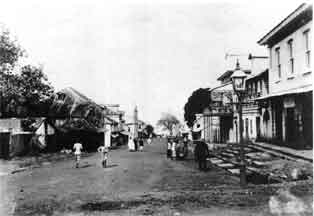1913 Mohandas Gandhi Arrested in Natal

Rioting broke out in Natal after the arrest of Mohandas Gandhi for protesting the recently- enacted immigration laws which restricted the freedom of movement of Asians. In the course of subsequent rioting, two were killed. .
In the early 20th century, South Africa was under British control and was a hotspot of racial tensions and discrimination. At the heart of these tensions was the burgeoning issue of Indian indentured labor. Thousands of Indians had come to the Natal colony, primarily to work on sugar cane plantations. However, once their labor contracts ended, many chose to stay, establishing businesses and families. Their presence, and subsequently their growing influence, alarmed both British colonial authorities and white settlers, leading to the implementation of discriminatory laws against the Indian community.
One such law, enacted in 1913, aimed to limit the freedom of movement of Asians, particularly Indians. This legislation required all Indians to carry passes and restricted their ability to conduct trade in the Transvaal. This was seen by many as a direct attack on the Indian community's rights and livelihoods.
Mohandas Gandhi, who later became globally renowned as Mahatma Gandhi, was at the forefront of the fight against such discriminatory practices. Gandhi had developed the concept of "Satyagraha" or nonviolent resistance, which he saw as a moral way to oppose unjust laws. He believed in the power of peaceful protest and civil disobedience as tools to achieve justice.
In response to the 1913 law, Gandhi organized and led protests, urging the Indian community in South Africa to defy the pass laws and other related restrictions. This act of civil disobedience culminated in Gandhi's arrest. His detention became a significant rallying point for the Indian community and others sympathetic to the cause.
Following Gandhi's arrest, tensions escalated quickly. Rioting broke out in various parts of Natal, reflecting the deep-seated frustrations of a community that felt marginalized and oppressed. As protests turned violent, clashes between demonstrators and the police ensued. Tragically, in the midst of the chaos, two individuals lost their lives, a somber testament to the high stakes of the struggle.
The rioting in Natal and the broader movement against discriminatory laws did eventually bear fruit. The South African government was forced to negotiate with Gandhi and other Indian leaders. This eventually led to the recognition of some Indian marriages and the removal of the £3 tax imposed on former indentured laborers.
While the immediate results of the 1913 protests might have seemed limited, they had a lasting impact. They marked a critical moment in the evolution of Gandhi's philosophy of nonviolent resistance, a philosophy he would carry with him back to India and use to challenge British rule there
 >
>